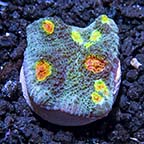
Additional locales and sizes may be available!
Additional locales and sizes may be available! Email me when availableQuick Stats
What do these Quick Stats mean? Click here for more information
What do these Quick Stats mean? Click here for more information
Overview
Did you know that this specimen ships from our LiveAquaria® Wisconsin Facility, home of our popular Diver's Den® WYSIWYG Store and our LiveAquaria® Certified Captive Grown Corals (CCGC)? What that means is that you can rest assured knowing this specimen received the highest level of care from our experienced and professional LiveAquaria® staff!
PLUS, hobbyists that use our LiveAquaria® Professional Reef Salt have the added benefit knowing marine species shipped from our LiveAquaria® Wisconsin Facility share the same water parameters. In other words, if you use our Professional Reef Salt, marine species shipped from our Wisconsin Facility will acclimate and transition to your home aquarium with less stress to set the foundation for longer term success.
The Trachyphyllia Brain Coral is a Large Polyp Stony (LPS) coral, often referred to as the Pacific Rose Coral, or an Open Brain Coral. It is easily collected from the reef because when mature, they are not attached to the substrate. Therefore, it is often found washed up in the shallow water lying on the sand bed. It is found in varying shades of green, metallic green and red and can be recognized by its irregular round shape, deep valleys, and fused walls with numerous folds. These characteristics originally identified Wellsophyllia corals as separate from Trachyphyllia corals. This distinction is less commonly used now, and the Wellsophyllia Brain Coral is often referred to now as a Trachyphyllia radiata coral.
It does best in a well established reef aquarium that incorporates moderate to strong lighting and a moderate water current within the aquarium, along with the addition of calcium, strontium, and other trace elements to the water. These corals prefer to be placed on a sandy substrate, with plenty of space between it and other corals, as it is sensitive to stings from its neighbors.
It contains the symbiotic algae zooxanthellae from which it receives the majority of its nutrition through photosynthesis. They also benefit from occasional feedings of meaty items, like shrimp, clam and squid. They should only be offered food when the tentacles are fully expanded, which is typically during the night time hours.
Approximate Purchase Size: Medium: 2-1/2” to 3-3/4”; Large: 3-3/4" to 5"
















